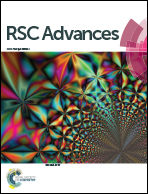Graphene reinforced carbon nanofiber engineering enhances Li storage performances of germanium oxide†
Abstract
The rational design of electrode materials with high power and energy densities, good operational safety, and long cycle life remains a great challenge for developing advanced battery systems. As a promising electrode material for rechargeable batteries, germanium oxide (GeO2) shows high capacity, but suffers from rapid capacity fading caused by its large volume variation during charge/discharge processes and poor rate performance owing to low intrinsic electronic conductivity. In this study, a novel one-dimensional (1D) carbon/graphene-nanocable–GeO2 nanocomposite (denoted as GeO2/nanocable) is rationally designed and prepared via a facile electrospinning method. Specifically, amorphous carbon and graphene spontaneously construct a nanocable structure, in which graphene acts as the “core” and amorphous carbon as the “shell”, and GeO2 nanoparticles are encapsulated in the nanocable. The graphene “core” promises good electrical conductivity while the amorphous carbon “shell” guarantees fast Li ions diffusion. When tested as an anode material for rechargeable lithium ion batteries, the GeO2/nanocable exhibits remarkable Li storage performance, including high reversible capacity (900 mA h g−1), high capacity retention (91% after 100 cycles), and good rate performance (595 mA h g−1 at 5000 mA g−1).

- This article is part of the themed collection: Editors' Collection: Lithium-ion batteries and beyond - materials, processes and recycling


 Please wait while we load your content...
Please wait while we load your content...